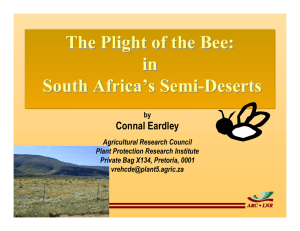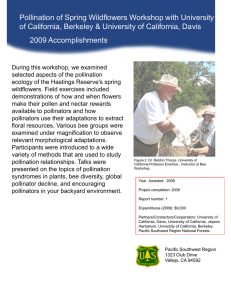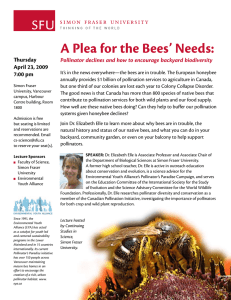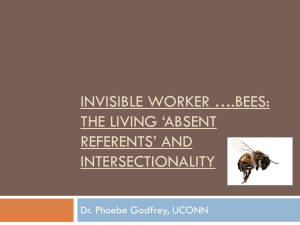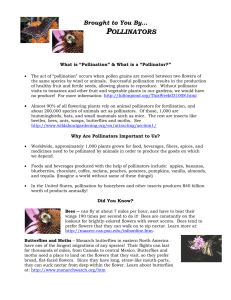Pollination and pollinators
advertisement
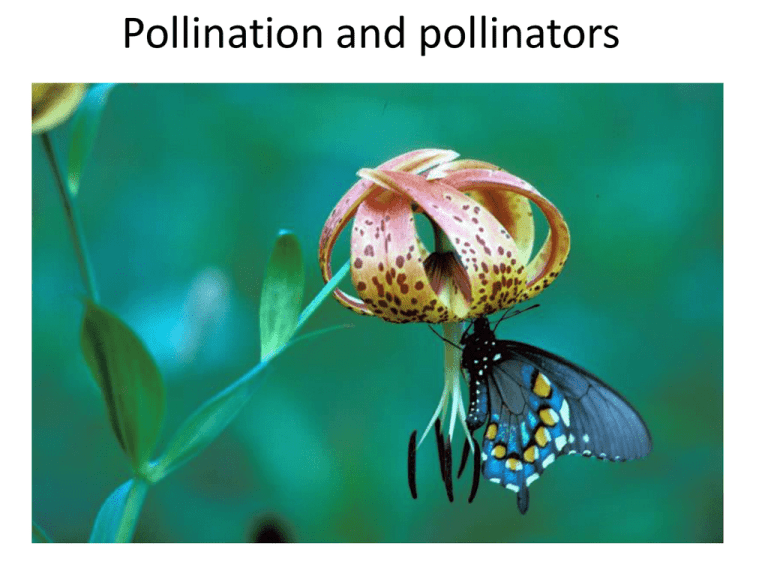
Pollination and pollinators Many types of pollinators Pollinators • Free ecosystem service • Links wild ecosystems with farming • Ag chemicals kill many pollinators • Not all crops have honeybee pollinators Basic Flower Structures Pollination is not an accident • Plants manipulate animal pollination at the cost of pollen, nectar, oils and waxes offered • Adult bees drink nectar for sugar • Pollen is high in protein which bees feed to larvae Skunk cabbage is a native wetland plant with beetle pollinators Weevils Pollinate Oil Palms red palm weevil larvae are eaten as a delicacy in New Guinea and Southeast Asia; Photo by Hegariz Palm Weevil + Coconut Palm disease •Its not a simple story though. •Red ring fungus disease has already killed up to 80% of coconut palms in parts of the Colombia. • The disease, on a nematode brought by the palm weevil causes the trees to wither and die. Eggplants in Africa • Eggplants in Kenya are bumblebee “buzz” pollinated (honeybees can’t do it!) • Two species of solitary forest bees do pollinate the eggplants. • As forests are cleared for farming, these pollinators are lost. Hand pollination in Africa Watermelons in California • Native bees on organic farms provide 100% pollination for organic watermelon crops. • “Conventional” farms had greatly reduced native bee populations + needed additional pollination. • Conservation and restoration of native bee habitats can be a successful strategy Wild bees + Honeybees affect each other The wild bumble bee + a honey bee collecting pollen on a sunflower. Honey bees that interact with wild, native bees are up to five times more efficient in pollinating sunflowers. (Sarah Greenleaf photos) Seeds grow next years crop! • Amaranthus greens are a traditional food in Africa, and must be grown from seed (hence) must be pollinated ! Valuing Pollination in $ • Foods high in vitamins and minerals like fruits and vegetables are mostly animal pollinated • Estimates of the value of pollination range from $120 - $200 billion / year • The wide range in estimated values results from the limited tools and focus appreciating the “free” service of pollination • Many honeybee pollinated crops benefit greatly from the addition of native pollinators Estimates of crop pollination • Bees pollinated 71 – 103 of 107 crops worldwide (Prescott-Allan 1990) • Bees pollinate 75% of 1330 cultivated crops (Roubik 1995) • Bees, birds + bats pollinate 35% world crops + increase outputs of 87 foodcrops (Klein 2006) Apple Pollination Apple varieties used as good cross - pollinators. Hedgerows are barriers + boundaries made up of trees, shrubs and herbs Wind breaks, any small areas and idle fields on farms can be critical habitat for pollinators Honeybee Monocultures • Corporate agriculture depends on only a few species and varieties of pollinators – mostly european honeybees • Trucking honeybees nationwide spreads pests + disease to native pollinators, and reduces genetic diversity • Many crops are better pollinated by nonhoneybees Pyrethrum insecticide • The Pyrethrum, an insecticide from Chrysanthemum flowers, is stronger if insect pollinate the flower Research Studies are Needed on the Diversity of Native Pollinators • To understand what is missing or declining, you need to know what species exist and what the interactions are! • Most information on taxonomy is in museums … • A single database to share information needed • Native crops usually have local native pollinators – but little is know about them The Pollinator Matrix • Native flowers may have different pollinators over time (years) • As each species flowering is limited to a specific part of a season, pollinators need many different species of flowers (and hence different species of plants) to survive over the year/season. • Pollinator populations may vary due to many environmental variables – parasites, habitat changes, climate • So, pollinator diversity depends on plant diversity Human Ecosystem Disturbance • So, a variety of flowers and pollinator types help to keep ecosystems functioning… until… • Humans disturb habitats with large monocultures and chemicals impacting native pollinators… so pollination service is lost • So….Humans turned to European + Asian honeybees to fill the loss
